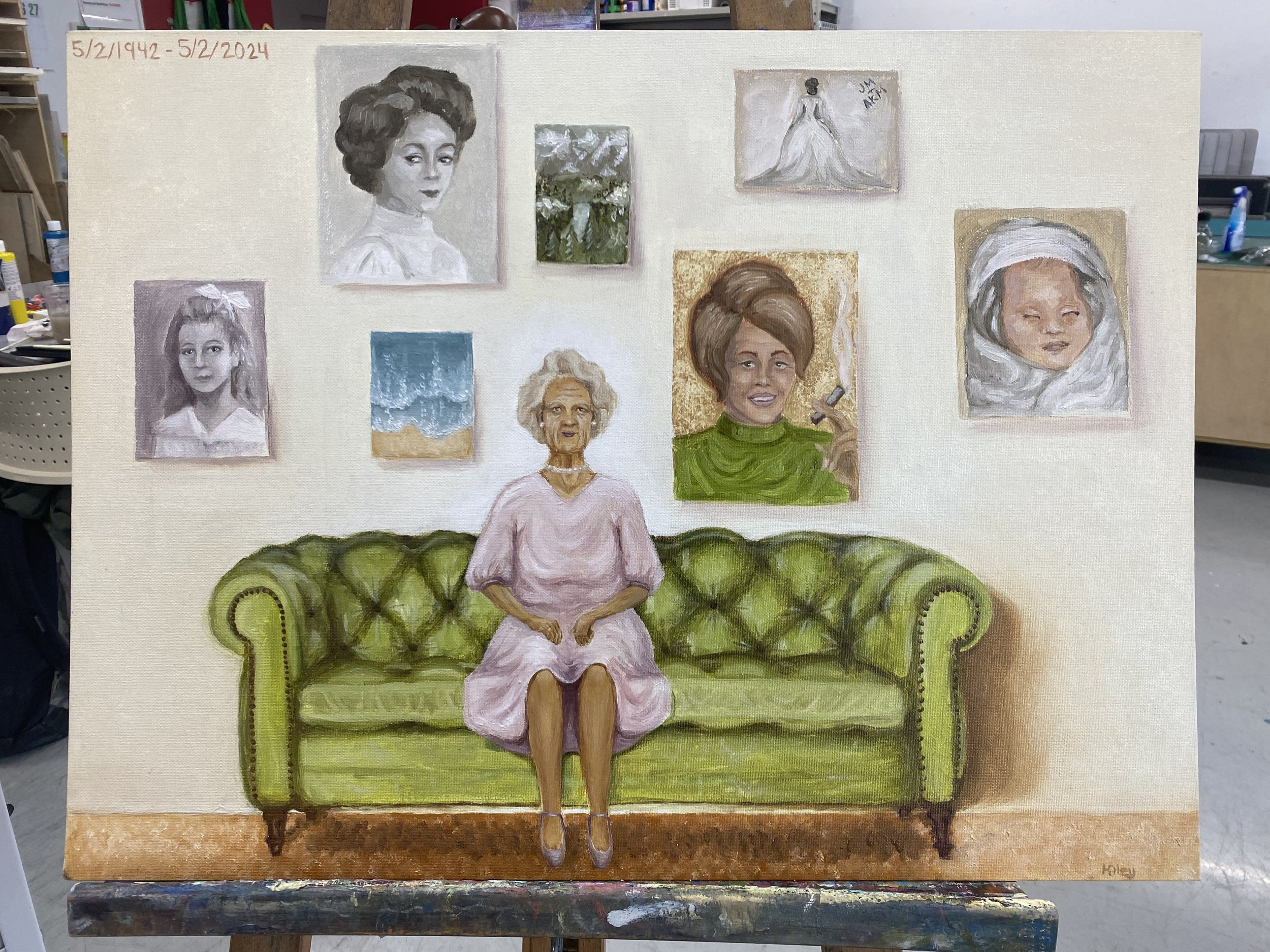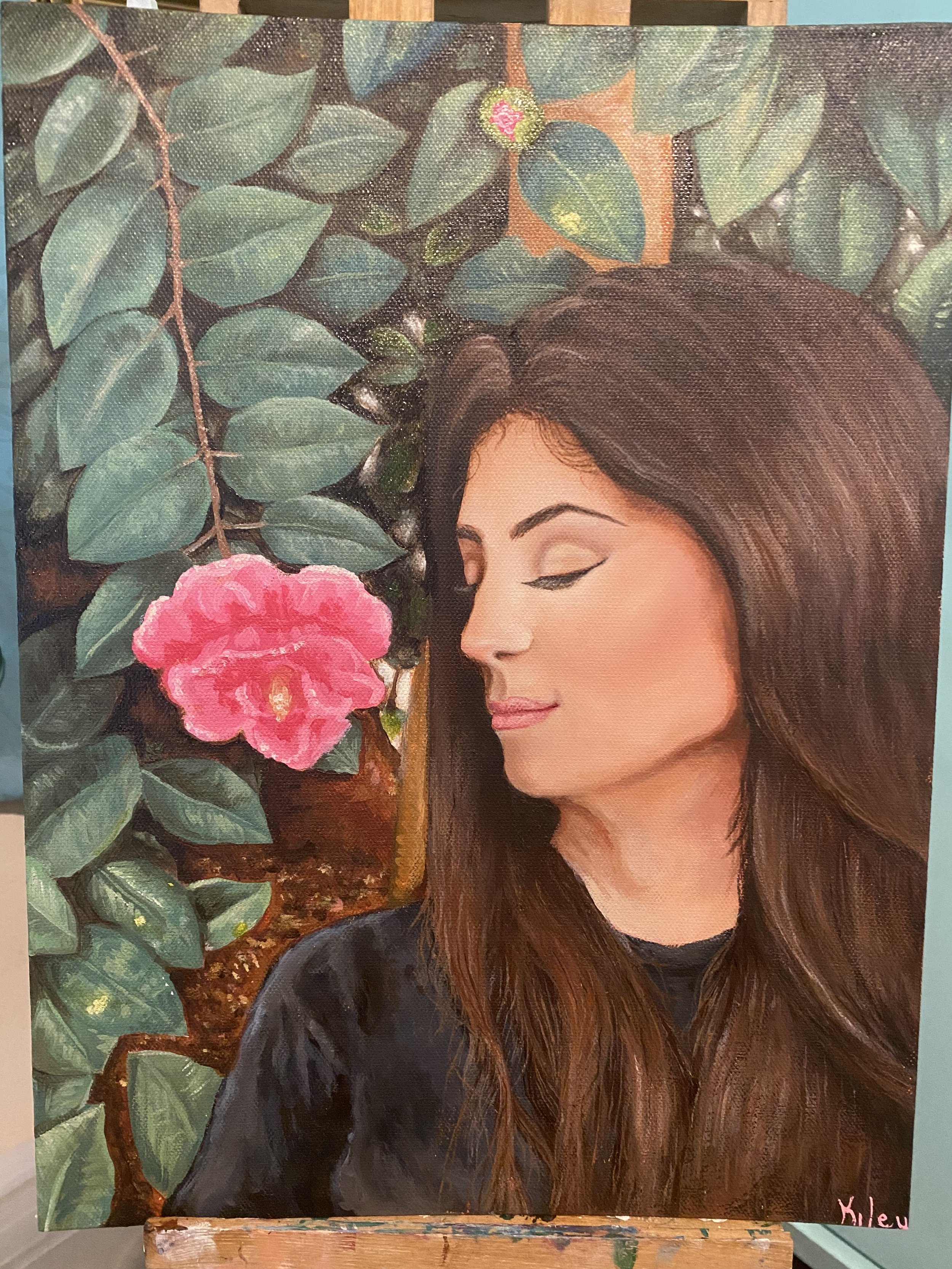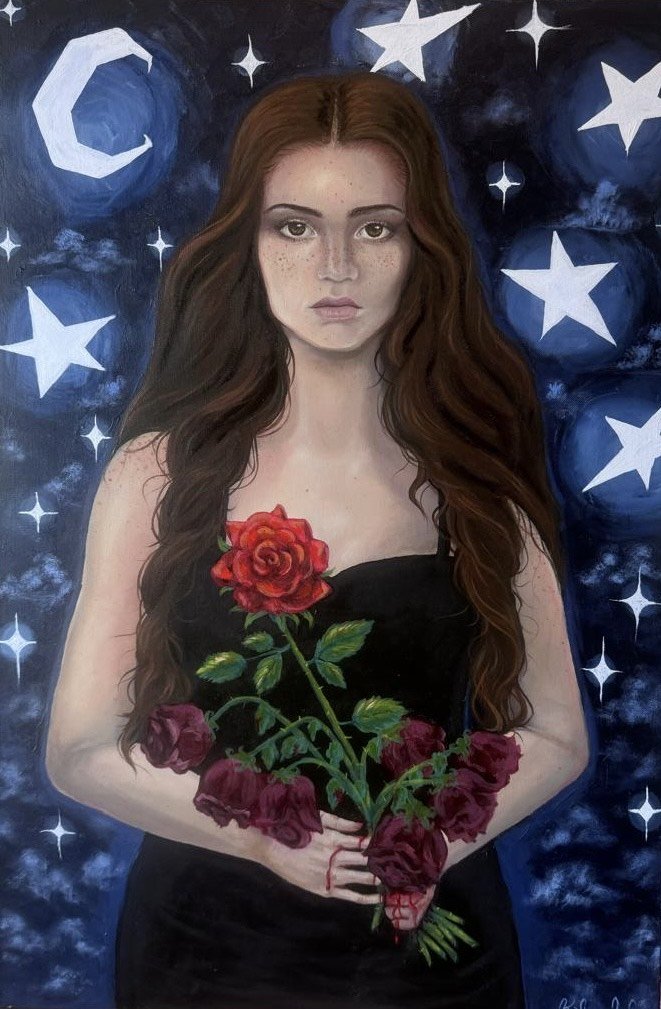049: Kiley Wright
Raised on Guam for the past 12 years, Kiley Wright is a gifted teenage artist with a deep passion for painting, especially capturing the complexity and individuality of the human face.
Kiley Wright
Wright has explored various mediums, portraiture has become her passion, offering her both challenges and fulfillment. Kiley views art as a physical representation of thoughts and feelings, allowing her to express her inner world while connecting with others. Her love for painting emerged early on, influenced by family members who are also artists, and by a pivotal experience at the Art Beat Guam summer camp, where she first explored portraiture. Since then, painting has remained central to her life and identity.
Kiley Wright
Wright’s artistic process begins with a spark of inspiration or a clear goal. Whether driven by a deadline, a commissioned project, or a spontaneous idea, she carefully plans each piece through brainstorming and sketching. Once satisfied with her rough drafts, she transitions to the canvas, starting with light layers of paint to establish the framework. This stage requires meticulous attention to proportion, as it sets the foundation for the final piece. After achieving balance in light, shadow, and shape, she shifts her focus to the details she enjoys most, breathing life into her portraits with intricate touches that add depth and emotion. Although she finds backgrounds less compelling, she recognizes their importance in grounding her subjects and enhancing the overall composition.
As a mostly self-taught artist, Wright acknowledges that accuracy is one of her biggest challenges. Striving to make her portraits as realistic as possible, she often feels there is room for improvement but uses these difficulties as opportunities for growth. Her commitment to practice has led to significant progress, particularly in recent years, as she has developed the ability to capture the subtleties that make each face unique. For Kiley, the process of creating art, though often tedious, offers a rewarding sense of accomplishment and continuous learning.
Kiley Wright
Wright sees artists as visual storytellers, preserving thoughts, emotions, and moments for future generations. She draws inspiration from many sources, including her own beliefs and feelings, as well as iconic figures like Leonardo Da Vinci and her own family. She believes that every artist, no matter their medium or experience, has something valuable to teach. This openness to learning and growth is reflected in her work, which seeks to convey the idea that each piece tells a story or reveals a deeper emotional truth.
Kiley Wright
Guam’s vibrant culture has played an integral role in shaping Wright’s artistic journey. She especially enjoys exploring the island’s rich culinary scene, from local restaurants to food trucks and festival markets, as a way to embrace the diverse influences around her. These experiences reflect her adventurous spirit and creative curiosity, which also guide her artistic exploration.
For aspiring artists, Kiley offers simple advice: practice not only your technical skills but also your creativity. For her, it is this combination that brings art to life, allowing it to connect with people across all cultures and backgrounds.
“Not only practice your skills, but practice honing your imagination and creativity in your work. ”
Kiley Wright
To read Kiley Wright’s full interview, continue reading below. Also, follow her artistic journey on her Instagram page (@k1ley_pa1nts). Thanks again!
Please introduce yourself and describe what you do.
My name is Kiley Wright I am a teenage artist living on guam for about 12 years now. I have practiced in many mediums but I am most passionate about painting.
How would you define art?
I would define art as the physical representation of thoughts and feelings.
Why did you choose your art form?
I chose to focus my work on mostly portrait paintings because of my own interest in the human face. All people are unique and complex and I see it as a great accomplishment when I can effectively and accurately capture them in a painting.
How does your background (education, culture, etc.) affect the artwork you make today?
Portraits are very challenging and I still struggle with aspects of it, but every new painting improves my understanding vastly. I focus my medium on painting because I enjoy how workable it is. I often make mistakes and Paint is very forgiving of that.
Who do you idolize?
I idolize many artists, from my family to big names like Leonardo Da Vinci. Every artist has something to teach, and it’s important we listen.
Where do you get your inspiration?
I get my inspiration from my own beliefs, thoughts, and feelings. I am also inspired by the human face. I’ve learned recently that involving personal experiences and feelings in my work creates a more human feeling to may work that is more than just raw effort.
What do you do when you're stuck on an artwork or lacking motivation or inspiration?
When I am stuck or lacking inspiration, I look to my thoughts. I let my imagination take the wheel when I brainstorm. I’ve also found it helpful to take a step back from my work whether that’s a couple hours or a couple weeks. I personally don’t like to force myself to push something out.
What do you like incorporating most into your art?
I most enjoy incorporating detail into my work. Small details add so much more depth to a piece than just the basic framework. Details can tell a deeper story with just their presence.
What is something that you add to your art as your signature?
I personally don’t have a certain signature on my works, other than an initial at the bottom right.
Take us through your process for making art.
My process for making art starts with a goal or an inspiration. Sometimes I have a deadline for a project, or a commission that must get started; other times an idea just comes to me and I have the need to put it into my visual medium. I then begin my brainstorming for how I want the piece to look. This involves many sketched drafts and consultations with the artistic people that surround me.
Once I’m happy with my rough idea I lightly sketch it onto a canvas and spray over the pencil with fixative. I work in light layers of paint to get the rough frame work of the subject. This is usually the hardest part because for my piece to be accurate to my subject it needs to have the right proportions. Your details can be spot on but if the proportions are off that can change the perception of the subject. After many hours of pushing and pulling shapes, shadows, and light; and i’m content with where i’m at, the fun part starts.
I get into the larger and smaller details. At this point I get to give the subject more dimension and depth. Like I mentioned earlier the details tell a story. Once the details give my subject a more human feel I start on my background.
I typically don’t enjoy backgrounds as much; they don’t interest me as much as portraits. However, backgrounds are important for grounding your subject, especially when it comes to lighting. Having a subject in dim lighting and a blank white background is not as interesting as a background that connects that lighting to the environment.
Once all these steps come together I wrap things up with my final additions and details till I feel happy with how it looks. At times, this all feels tedious and difficult when I lose inspiration, but it is a rewarding process that teaches me more and more each time.
What do you struggle with the most when making art?
When I’m making art I struggle the most with accuracy. Personally, when I am painting my goal is to make my work look as accurate as possible. It seems there’s always something missing from my work that could make it that much better. Since I am mostly self taught, it’s difficult to identify what I’m doing right or wrong. I take this into consideration when i paint and try not to be too hard on myself, but it can get frustrating.
What role do artists have in society?
I see artists as the visual storytellers of society. When looking back at paintings from centuries ago, it’s fascinating to witness their beauty. Along with that, paintings show us a window into the past. Where you can see more than just the subject, but the artist’s thoughts and feelings.
What characteristics do you think all artists share?
I think all artists share a sense of creativity. It may be obvious but it’s necessary to any art form. Every artist is creative enough to come up with their own ideas, thoughts, and feelings, and show that to the world. Creativity is a necessity for an artist.
What’s your favorite place in Guam?
My favorite place in guam is the countless different restaurants. I’m a bit of a foodie, and being so close to Asia there are so many things to try. Going to festivals/nigh markets and trying things from all the different stands and food trucks is always fun for me.
How has your artwork evolved over time?
Since I’m on the younger side, I haven’t seen too much evolution in my work. When I was elementary age I would draw lots, but nothing mind-blowing. When I was 9 I attended the Art Beat Guam summer camp where I found painting to be very enjoyable to me. I remember one of the teachers saying that Portraits are one of the hardest things to draw. So naturally I fell into portrait drawing. From my own judgment, my portraits in previous years lacked the accuracy I was looking for. Up until about a year ago is when I started seeing much more improvement. This was also about the time I started practicing more. So yes, practice makes perfect.
Why did you choose to become an artist?
I wouldn’t say I choose to become an artist. I think it was just something I was drawn to (literally). Much of my family is artists, so maybe it’s in my blood to be creative. Art, and especially painting, has always just held my attention much more than any other hobby or activity.
Is your art geared towards a specific audience?
I don’t intend on limiting my audience to one demographic. I’d like my art to communicate to all sorts of people, but with the topics and subjects I focus on, I could see how my audience was of a more feminine demographic.
Do you have any tips for aspiring artists?
My biggest tip for aspiring artists is a bit basic, but you need to practice. Not only practice your skills, but practice honing your imagination and creativity in your work. These are the things that really bring art to life.






